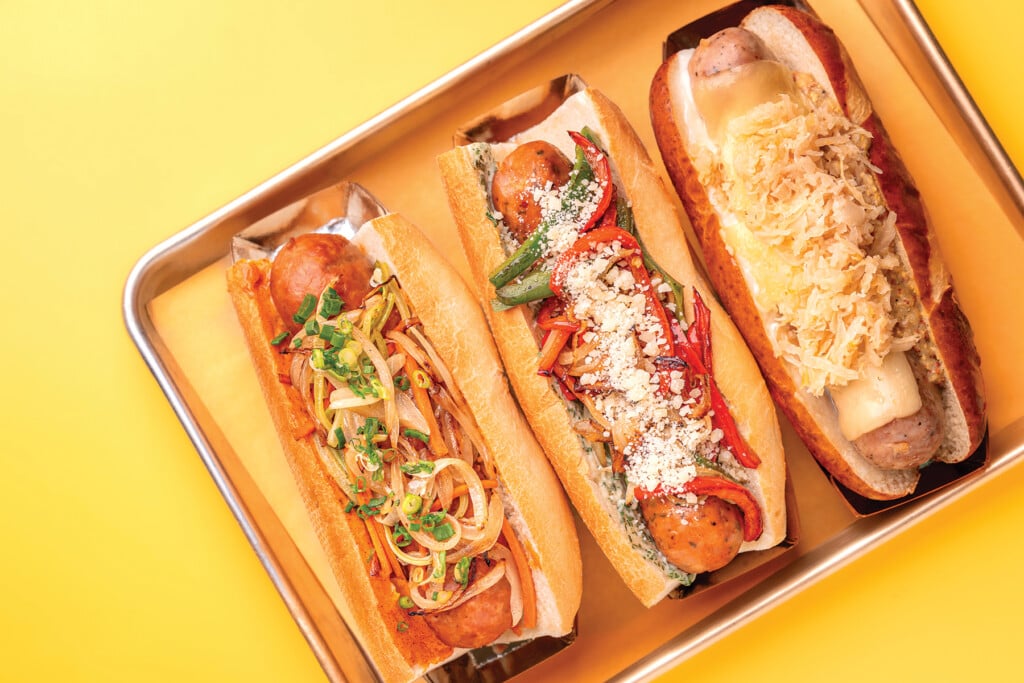How the Sausage is Made
Midtown welcomes Link Sausages & Beer

July is National Hot Dog Month, and what better way to celebrate than by swinging by Tallahassee’s newest offering in the sausage space, Link Sausages & Beer? Part of Jesse Edmunds’ Seven Hills Hospitality Group (which also includes Liberty Bar & Restaurant, Black Radish, The Hawthorn, Bar 1903, and Rae’s), Link opened earlier this year in the spot that used to be home to El Cocinero.
According to the National Hot Dog and Sausage Council, Americans consume about 20 billion hot dogs annually, averaging out to an estimated 70 hot dogs per person each year. “[Sausage] is a 5,000-year-old food,” says Edmunds. “It’s something that is deeply ingrained in almost every culture on the planet.”
The earliest recorded instance of sausage making was in ancient Sumeria, around 3100 B.C.E. But wait, let’s pump the brakes to pose an age-old question: Is a sausage a hot dog? Is a hot dog a sausage?
According to Edmunds, “A hot dog is a sausage,” however, not all sausages are hot dogs. A sausage is defined as any seasoned ground meat inside of a casing. A hot dog may or may not have a casing and follows a specific type of emulsification that lends itself better to factory-based production. A hot dog is generally served inside of a bun, while sausages are often served solo, inside a bun, or alongside various accompaniments.
The links at Link are made entirely in-house from premium ingredients. “We get whole pork shoulders, whole briskets, whole chucks … grind it, mix everything, case it,” explains Edmunds, who adds that the whole process takes three days. “I started making my own charcuterie when I opened Liberty Bar, and that’s where I really got into it.”
Edmunds has spent years perfecting the art of sausage making. While it is a seemingly easy process, “It takes a lot of culinary integrity to make it well,” he notes.
On day one, the meat arrives and is broken down, and the mix-ins are prepped. Every ingredient is measured to the gram. Edmunds has set ratios in spreadsheets to ensure quality and consistency. “You want to create a consistent product, but everything you’re making it with is so inconsistent. You’re really trying to bring order to chaos.”
Day two involves grinding and mixing everything together. This is also when the pink curing salt is added and combines with proteins in the meat to produce nitric oxide, which acts as a bacterial inhibitor. The mixture sits in the fridge for a full 24 hours after mixing for this conversion to take place. “You’re not actually eating nitrites,” Edmunds notes, “because we’ve gone through that full process before we go to cook it.”
On day three, it is finally time to case the sausage. All of Link’s sausages have an all-natural pork casing. Kitchen manager Anna Linnankivi cases the sausage with skill and ease using a pressurized machine that looks like a giant French press. The sausages are then cooked and/or smoked and ready for service.
Link’s menu features a selection of signature dogs, burgers, and salads, as well as classic American sides like baked beans, pub fries, and white baked mac and cheese. The beer-battered onion rings are a standout. The burgers all feature Wagyu beef and are not to be missed.
The signature dogs feature sausages from around the globe that most should recognize. Eventually, Edmunds hopes to be a bit more adventurous and feature sausages of the month. “We really wanted to start with things that are comfortable,” he says. “These are the classics for a reason.”
Link’s bratwurst is a bestseller. It is served on a pretzel bun, with beer mustard, garlic aioli, sauerkraut, and melty Gruyére cheese. The homemade pickles provide the perfect sour-salty contrast to the unctuous dogs, and the signature sauces help balance everything together.
The team at Link strives to take influence from various places to make the dogs entirely their own. On the chorizo dog, for example, Edmunds explains that while the taste is more in line with Mexican flavors, the texture is similar to an Argentinian-style chorizo. “Mexican-style chorizo uses red wine vinegar while Spanish-style chorizo uses red wine,” he continues. “Acid breaks the bond of emulsification between fat. It’s not that Mexican chorizo is fattier; it just doesn’t hold the emulsification as well.”
The chorizo dog is served on a Hawaiian sweet bun with garlic aioli, griddled onions, and caramelized pineapple and is very much in the running for this writer’s favorite.
Link is open seven days a week and offers dine-in and carry-out, as well as retail options—meaning those who feel so inclined can take home the restaurant’s sausages, sauces, and pickles and craft their own hot dog at home




